Jay
Forum Replies Created
-
JayParticipant
@Karen Thanks, Karen! The comic layout software I used is called, "Comic Life" (https://apps.apple.com/us/app/comic-life-3/id688953417?mt=12), which makes it really easy and fun to place one's images in comic-book-like frames.
in reply to: Activities: Keeping Track of Your Birdwatching #708460 -
JayParticipantActivity 2: Thinking about the Seven Simple Actions to Protect Birds, there are a few I’m doing already but more that I need to make a more concerted effort to practice. 1) Making windows safer. I’ve been shocked by the scale and scope of the problem with birds and glass (https://abcbirds.org/blog/truth-about-birds-and-glass-collisions). BirdNote also had a good episode on the problem (https://www.birdnote.org/birds-glass). The front window of our home is a culprit, so I’d like to try one of these products (https://abcbirds.org/get-involved/bird-smart-glass/). The Zen Curtain or Feather Friendly solutions look promising. I’d welcome anyone’s thoughts or experience with these products. 2) Keep cats indoors. Not applicable in my case, but I sent some info around our neighborhood mail group, reminding folks to try keeping cats indoors or on “Catios” — especially during the spring nesting season. 3) Plant native plants. This has been an amazing (and fun) transformation for my back garden. Thanks to the course for the link to Audubon’s resources (https://www.audubon.org/PLANTSFORBIRDS). 4) Reduce pesticide use. Proud to say that I’m not using any. I’ve used neem oil in certain cases for pest insects on leafy plants (http://npic.orst.edu/factsheets/neemgen.html). Collectively, I’m sure lawns must be one of the worst offenders. Folks dump all kinds of stuff on their front lawns and then (at least it seems to me) never use them anyway. I’m slowly shrinking the size of my lawn with native plantings and, otherwise, letting a variety of mosses, clovers, and wild violets take over. I keep them trimmed so as not to be a total social outcast! 5) Drink coffee that’s good for birds. Wowzers. This cuts close to home. I’d assumed my favorite Peet’s coffee was bird friendly or shade grown.. but, apparently not! Can’t find anything on their website about it let alone product labels. The Smithsonian has this useful resource for finding such coffees (https://nationalzoo.si.edu/migratory-birds/where-buy-bird-friendly-coffee)… needless to say, I’m looking for a new brand! 6) Reduce and reuse plastics. Hardly any plastics are recyclable in my area (only numbers 1 & 2). However, I’ve found a nearby town that accepts #5. For other plastic films/bags, I’ve found that nearby grocery chains accept these along with store bags. 7) Citizen science. This is definitely one of the more fun ones. This course has been a great introduction to eBird, Feeder Watch, and the Great Backyard Bird Count.in reply to: Activities: Helping Birds in Your World #704038
-
JayParticipantSo much to love (and respect!) about this post. Thanks for sharing -- and for your advocacy on behalf of birds.in reply to: Activities: Helping Birds in Your World #704011
-
JayParticipantSigh... yes, a depressingly common "habitat" these days... the neighborhood was probably called something like, "Hidden Grove." Pretty hidden alright... Otherwise, great post -- and thanks for continuing to explore even in suburban wasteland!in reply to: Activities: Exploring Bird Habitats #701219
-
JayParticipantVery cool! I recently started making audio recordings too. I mention it in my post, but you might checkout Cornell Lab's free "Raven" software for visualizing the sounds you record. It's fun and has brought a new dimension to birding: https://ravensoundsoftware.comin reply to: Activities: Keeping Track of Your Birdwatching #701213
-
JayParticipantActivity 1: I tried combining a few elements from my observations (photography taken, sound recordings made, research done) to retell a sighting from over the weekend… but in comic form. It’s probably not a very sustainable way of making field notes… but I found it a fun way to capture and communicate a memory. See what you think!
 in reply to: Activities: Keeping Track of Your Birdwatching #701211
in reply to: Activities: Keeping Track of Your Birdwatching #701211 -
JayParticipantActivity 1: This optional activity was a bit more challenging given widespread park closures, uncooperative weather, etc., but I found it very rewarding: different habitat, different birds! I guess I’d never really paid careful attention to it — and especially not while traversing among habitats.
 Open habitats: I drove to a parking area along a road adjacent to cow pastures. Along the fence line, I spotted a number of Tree Swallows (https://www.allaboutbirds.org/guide/Tree_Swallow/) going in and out of nest boxes there and also zipping and darting through the air above the field. Leaving the parking area on foot, I saw a Barn Swallow (https://www.allaboutbirds.org/guide/Barn_Swallow/), who, I kid you not, flew out of a barn! It was possible to further distinguish him by his deeply forked tail and orange-brown underside. Soaring above the fields were a few Turkey Vultures (https://www.allaboutbirds.org/guide/Turkey_Vulture/), judging by the gray flight feathers. They were riding thermals and looking for, presumably, dead stuff.
Open habitats: I drove to a parking area along a road adjacent to cow pastures. Along the fence line, I spotted a number of Tree Swallows (https://www.allaboutbirds.org/guide/Tree_Swallow/) going in and out of nest boxes there and also zipping and darting through the air above the field. Leaving the parking area on foot, I saw a Barn Swallow (https://www.allaboutbirds.org/guide/Barn_Swallow/), who, I kid you not, flew out of a barn! It was possible to further distinguish him by his deeply forked tail and orange-brown underside. Soaring above the fields were a few Turkey Vultures (https://www.allaboutbirds.org/guide/Turkey_Vulture/), judging by the gray flight feathers. They were riding thermals and looking for, presumably, dead stuff.
 Forested habitats: Following the trail led me first into a mature forest. I could hear a number of different songs and calls but, this being decidedly not my backyard, the sounds were unfamiliar to me. I found it frustrating to be very close to birds but not able to see any… until a brilliant red caught my eye, high in the canopy: Scarlet Tanager (https://www.allaboutbirds.org/guide/Scarlet_Tanager/) hunting (?) along a branch. Merlin helped me to quickly identify this bird and listening to the in-app sound clips made me realize that I’d been hearing him all along! In the more open, second-growth part of the forest, I saw a pair of familiar American Goldfinches (https://www.allaboutbirds.org/guide/American_Goldfinch/) and a few less familiar Blue-gray Gnatcatchers (https://www.allaboutbirds.org/guide/Blue-gray_Gnatcatcher/) — the latter identified by their long, mostly black tails with white edges (helpful, since they were flitting about quickly overhead and hardly paused!). Finally, there was a bird that I wasn't able to see clearly enough to identify (I only have a pair of 8x21s after all): it was sparrow-sized and appeared to be feeding from a bloom high in the treetops. I guess it's good to always have at least one mystery to ponder. in reply to: Activities: Exploring Bird Habitats #699826
Forested habitats: Following the trail led me first into a mature forest. I could hear a number of different songs and calls but, this being decidedly not my backyard, the sounds were unfamiliar to me. I found it frustrating to be very close to birds but not able to see any… until a brilliant red caught my eye, high in the canopy: Scarlet Tanager (https://www.allaboutbirds.org/guide/Scarlet_Tanager/) hunting (?) along a branch. Merlin helped me to quickly identify this bird and listening to the in-app sound clips made me realize that I’d been hearing him all along! In the more open, second-growth part of the forest, I saw a pair of familiar American Goldfinches (https://www.allaboutbirds.org/guide/American_Goldfinch/) and a few less familiar Blue-gray Gnatcatchers (https://www.allaboutbirds.org/guide/Blue-gray_Gnatcatcher/) — the latter identified by their long, mostly black tails with white edges (helpful, since they were flitting about quickly overhead and hardly paused!). Finally, there was a bird that I wasn't able to see clearly enough to identify (I only have a pair of 8x21s after all): it was sparrow-sized and appeared to be feeding from a bloom high in the treetops. I guess it's good to always have at least one mystery to ponder. in reply to: Activities: Exploring Bird Habitats #699826 -
JayParticipant
@Kevin Thanks for the add'l info, Kevin! I'll keep an eye out for lil' "Whitey" -- I've since seen 4-5 Chipping Sparrows at a time (foraging for insects on my patio). Hopefully, Whitey's pals won't hold his abnormality against him.
in reply to: Activities: Local Bird Exploration #696782 -
JayParticipantKeep those four-legged fluff balls safely ensconced in "cat patios" to protect our bird friends -- especially during nesting season! https://www.allaboutbirds.org/news/faq-outdoor-cats-and-their-effects-on-birds/in reply to: Activities: Noticing Behaviors #696780
-
JayParticipantActivity 1: It was quite rainy today but, nevertheless, the birds were out exhibiting a range of the behaviors described in the lesson. As Kevin said: “To survive, a bird needs to eat and not get eaten.” These are a few of the behaviors I observed: Foraging for food — catching insects: this Downy Woodpecker flew from tree trunk to tree trunk and, starting at the bottom and working her way up, proceeded to hunt for and eat (I’m assuming) insects.
 Self care — beak cleaning: although I missed the quintessential act, you’ll have to take my word for it that a Northern Cardinal was cleaning his beak on a branch!
Parental behavior — feeding young: a House Sparrow went between the feeder and the feeder arm, bringing food to her cheeping fledgling (you can just make out the baby’s open and waiting mouth in this shot). I guess this pesky invasive has already successfully hatched a new brood…
Self care — beak cleaning: although I missed the quintessential act, you’ll have to take my word for it that a Northern Cardinal was cleaning his beak on a branch!
Parental behavior — feeding young: a House Sparrow went between the feeder and the feeder arm, bringing food to her cheeping fledgling (you can just make out the baby’s open and waiting mouth in this shot). I guess this pesky invasive has already successfully hatched a new brood…
 As I said, it was quite rainy, and I often wonder… what do birds do when it rains really hard? Perhaps this Mourning Dove has the answer: he (or she) sat very still in a tree with his/her head tilted upward, as if exposing a smaller profile to the sky(?).
As I said, it was quite rainy, and I often wonder… what do birds do when it rains really hard? Perhaps this Mourning Dove has the answer: he (or she) sat very still in a tree with his/her head tilted upward, as if exposing a smaller profile to the sky(?).
 in reply to: Activities: Noticing Behaviors #696777
in reply to: Activities: Noticing Behaviors #696777 -
JayParticipantActivity 2: This was a fun activity (modified slightly to focus on three instead of six birds)! The animated range maps add interesting dimensions to my bird watching: “when” and “where.” So, now, in addition to thinking about what I saw, I can also consider what I might -- or might not -- see next. Dark-eyed Junco in late March. This was one of the last times this year that I saw this inquisitive little fellow. According to the abundance animation (https://ebird.org/science/status-and-trends/daejun/abundance-map-weekly), they’ve largely migrated to the Northern United States and Canada by this time of year but should be returning in the fall.
 American Goldfinch in early April. While not a good photo, this was the first time since last year that I’d seen these birds. According to the animation (https://ebird.org/science/status-and-trends/amegfi/abundance-map-weekly), however, they could be present in my area throughout the year. Perhaps nonbreeding plumage or an overall lower density in winter help explain their apparent absence.
American Goldfinch in early April. While not a good photo, this was the first time since last year that I’d seen these birds. According to the animation (https://ebird.org/science/status-and-trends/amegfi/abundance-map-weekly), however, they could be present in my area throughout the year. Perhaps nonbreeding plumage or an overall lower density in winter help explain their apparent absence.
 Gray Catbird in late April. I remember seeing these dapper fellows last year and am pleased to have noted one’s arrival the other (rainy) day. According to the animation (https://ebird.org/science/status-and-trends/grycat/abundance-map-weekly), these birds spend the non-breeding season along the Gulf Coast, the Caribbean, and in parts of Central America before moving into the midwest and northeastern parts of the United States.
Gray Catbird in late April. I remember seeing these dapper fellows last year and am pleased to have noted one’s arrival the other (rainy) day. According to the animation (https://ebird.org/science/status-and-trends/grycat/abundance-map-weekly), these birds spend the non-breeding season along the Gulf Coast, the Caribbean, and in parts of Central America before moving into the midwest and northeastern parts of the United States.
 Travel safe, bird friends! in reply to: Activities: Different Seasons, Different Birds #695653
Travel safe, bird friends! in reply to: Activities: Different Seasons, Different Birds #695653 -
JayParticipantYou know... I think it looks a lot like the American Goldfinches posted in a photo in the next lesson! https://academy.allaboutbirds.org/topic/activities-local-bird-exploration/ Check it out!
 in reply to: Activities: Bird ID Practice #695142
in reply to: Activities: Bird ID Practice #695142 -
JayParticipant
@Carole Oh no! That's incredibly sad... they do, indeed, appear to like to eat ants. I see them often pecking around the base of trees. I'll look more into the issue you raise and try and make my neighborhood aware as well.
in reply to: Activities: Exploring Birds #695139 -
JayParticipantActivity 1. What a wonderful exercise, and I confess to spending more than 15 minutes on it! Before I knew it, the entire morning had passed… In all, I spotted 17 different species.
- Many were familiar to me from previous visits (e.g., Carolina Chickadee, White-breasted Nuthatch, Northern Cardinal, etc.), but a few I hadn’t seen since last year (e.g., Gray Catbird, who, from its range map, seems to winter along the Gulf Coast).
- One bird, which I wasn’t able to positively ID is pictured below left. He moved about on the ground and was smaller than a House Sparrow. Merlin ID suspects him of being a Chipping Sparrow, but his all white face is throwing me off. What do you think? Has anyone else seen a bird like this?
 in reply to: Activities: Local Bird Exploration #695119
in reply to: Activities: Local Bird Exploration #695119 -
JayParticipant
@cindy Go for it! You’ll probably find many are European House Sparrows... but, stick with it, the native sparrows are quite interesting!! (And you’ll def. be able to tell Carolina Wren from his high-volume/high-energy song as well as his distinctive shape and feeding habit)!
in reply to: Activities: Bird ID Practice #694130 -
JayParticipantActivity 2: Telling sparrows apart is one of the more challenging tasks I’ve faced since I began birdwatching… and I’m definitely still learning! I find it easy to mistake the Song Sparrow with the White-throated Sparrow. Both are brown with facial stripes and even share similar white eyebrows! They also both feed on the ground, though I believe the White-throated Sparrow is more apt to perform the two-footed kick maneuver that Kevin describes. The Song Sparrow, however, has a speckled chest as compared with the White-throated Sparrow’s distinctive white throat patch and yellow eye markings (though the latter do not seem to always be so pronounced). Finally, the female House Sparrow (pesky, invasive little buggers) also appear quite similar from a distance. They are small and brown colored (soft/gray-brown chest and belly with a striped back). What do you think? Can you tell them apart from these descriptions?


 in reply to: Activities: Bird ID Practice #694034
in reply to: Activities: Bird ID Practice #694034 -
JayParticipant
@cindy Thanks! It's pretty amateur but has nevertheless been a lot of fun... Setup is like this: https://www.celestron.com/products/ultima-80-45-degree-spotting-scope-with-smartphone-adapter
in reply to: Activities: Exploring Birds #693979 -
JayParticipant
@Marjorie Thank you! Yes, it's far from a perfect solution... I use a Celestron spotting scope and my phone (now with an adapter, which makes it much easier)!
in reply to: Activities: Exploring Birds #693287 -
JayParticipantActivity 2. Woodpeckers: a Northern Flicker pair (female in front, male in back). I’ve also spotted a second female this spring who will “joust” with the other female. I’m assuming these belong to the “woodpecker” group, because they climb along tree trunks, but I see them more commonly pecking at the ground.
 Songbirds/Finches and buntings: a Northern Cardinal pair (female in front, male in back). Spring is truly in the air as a number of pairs seem to be competing for a “top spot” in the yard!
Songbirds/Finches and buntings: a Northern Cardinal pair (female in front, male in back). Spring is truly in the air as a number of pairs seem to be competing for a “top spot” in the yard!
 Songbirds/Other: a Blue Jay pair (I’m not sure of the sex… but I like to imagine one of each). The Blue Jay didn’t fit nicely into the course’s Songbird categories, but I looked on AllAboutBirds and see that they belong to the crow family (Corvidae).
Songbirds/Other: a Blue Jay pair (I’m not sure of the sex… but I like to imagine one of each). The Blue Jay didn’t fit nicely into the course’s Songbird categories, but I looked on AllAboutBirds and see that they belong to the crow family (Corvidae).
 in reply to: Activities: Exploring Birds #693151
in reply to: Activities: Exploring Birds #693151

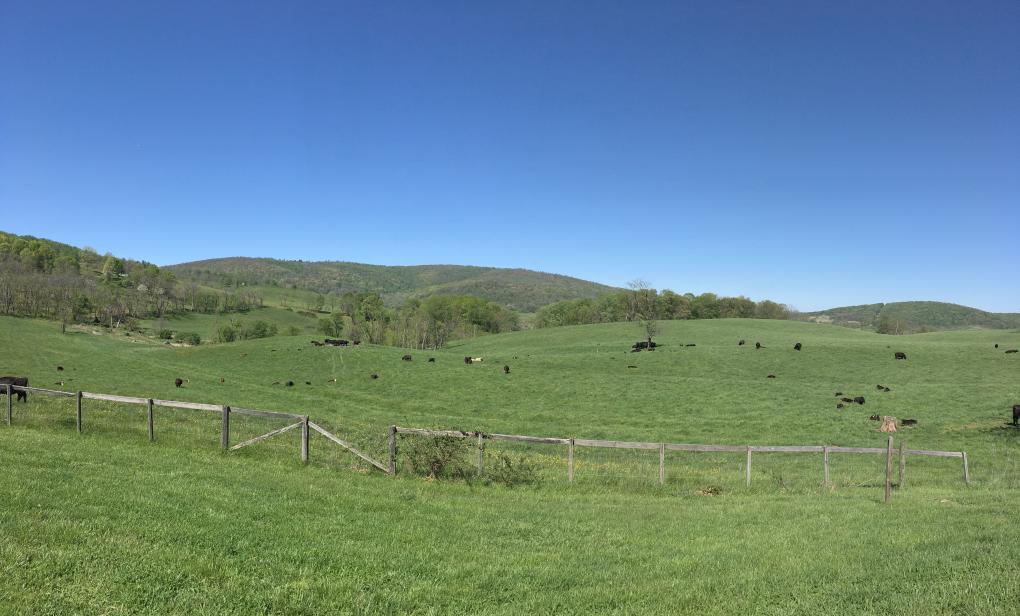 Open habitats: I drove to a parking area along a road adjacent to cow pastures. Along the fence line, I spotted a number of Tree Swallows (https://www.allaboutbirds.org/guide/Tree_Swallow/) going in and out of nest boxes there and also zipping and darting through the air above the field. Leaving the parking area on foot, I saw a Barn Swallow (https://www.allaboutbirds.org/guide/Barn_Swallow/), who, I kid you not, flew out of a barn! It was possible to further distinguish him by his deeply forked tail and orange-brown underside. Soaring above the fields were a few Turkey Vultures (https://www.allaboutbirds.org/guide/Turkey_Vulture/), judging by the gray flight feathers. They were riding thermals and looking for, presumably, dead stuff.
Open habitats: I drove to a parking area along a road adjacent to cow pastures. Along the fence line, I spotted a number of Tree Swallows (https://www.allaboutbirds.org/guide/Tree_Swallow/) going in and out of nest boxes there and also zipping and darting through the air above the field. Leaving the parking area on foot, I saw a Barn Swallow (https://www.allaboutbirds.org/guide/Barn_Swallow/), who, I kid you not, flew out of a barn! It was possible to further distinguish him by his deeply forked tail and orange-brown underside. Soaring above the fields were a few Turkey Vultures (https://www.allaboutbirds.org/guide/Turkey_Vulture/), judging by the gray flight feathers. They were riding thermals and looking for, presumably, dead stuff.
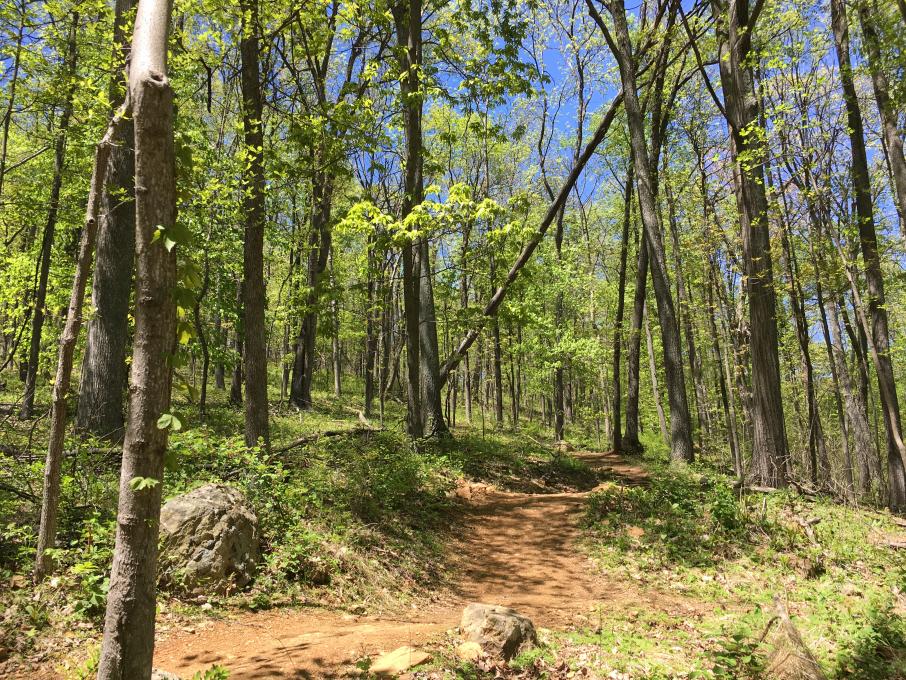 Forested habitats: Following the trail led me first into a mature forest. I could hear a number of different songs and calls but, this being decidedly not my backyard, the sounds were unfamiliar to me. I found it frustrating to be very close to birds but not able to see any… until a brilliant red caught my eye, high in the canopy: Scarlet Tanager (https://www.allaboutbirds.org/guide/Scarlet_Tanager/) hunting (?) along a branch. Merlin helped me to quickly identify this bird and listening to the in-app sound clips made me realize that I’d been hearing him all along! In the more open, second-growth part of the forest, I saw a pair of familiar American Goldfinches (https://www.allaboutbirds.org/guide/American_Goldfinch/) and a few less familiar Blue-gray Gnatcatchers (https://www.allaboutbirds.org/guide/Blue-gray_Gnatcatcher/) — the latter identified by their long, mostly black tails with white edges (helpful, since they were flitting about quickly overhead and hardly paused!). Finally, there was a bird that I wasn't able to see clearly enough to identify (I only have a pair of 8x21s after all): it was sparrow-sized and appeared to be feeding from a bloom high in the treetops. I guess it's good to always have at least one mystery to ponder.
Forested habitats: Following the trail led me first into a mature forest. I could hear a number of different songs and calls but, this being decidedly not my backyard, the sounds were unfamiliar to me. I found it frustrating to be very close to birds but not able to see any… until a brilliant red caught my eye, high in the canopy: Scarlet Tanager (https://www.allaboutbirds.org/guide/Scarlet_Tanager/) hunting (?) along a branch. Merlin helped me to quickly identify this bird and listening to the in-app sound clips made me realize that I’d been hearing him all along! In the more open, second-growth part of the forest, I saw a pair of familiar American Goldfinches (https://www.allaboutbirds.org/guide/American_Goldfinch/) and a few less familiar Blue-gray Gnatcatchers (https://www.allaboutbirds.org/guide/Blue-gray_Gnatcatcher/) — the latter identified by their long, mostly black tails with white edges (helpful, since they were flitting about quickly overhead and hardly paused!). Finally, there was a bird that I wasn't able to see clearly enough to identify (I only have a pair of 8x21s after all): it was sparrow-sized and appeared to be feeding from a bloom high in the treetops. I guess it's good to always have at least one mystery to ponder. 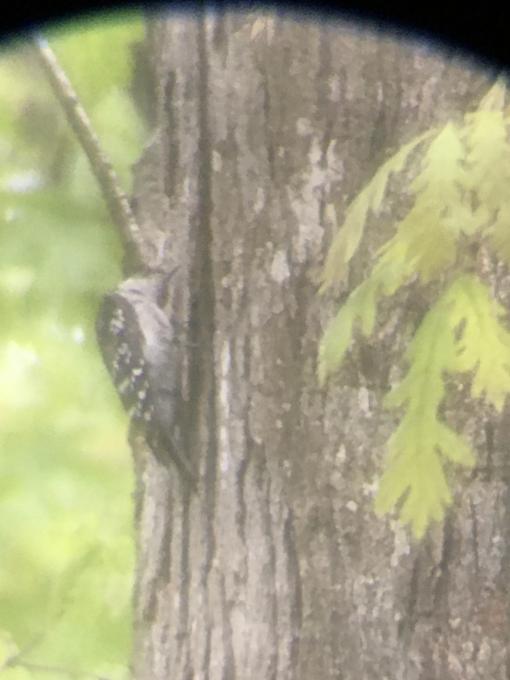 Self care — beak cleaning: although I missed the quintessential act, you’ll have to take my word for it that a Northern Cardinal was cleaning his beak on a branch!
Parental behavior — feeding young: a House Sparrow went between the feeder and the feeder arm, bringing food to her cheeping fledgling (you can just make out the baby’s open and waiting mouth in this shot). I guess this pesky invasive has already successfully hatched a new brood…
Self care — beak cleaning: although I missed the quintessential act, you’ll have to take my word for it that a Northern Cardinal was cleaning his beak on a branch!
Parental behavior — feeding young: a House Sparrow went between the feeder and the feeder arm, bringing food to her cheeping fledgling (you can just make out the baby’s open and waiting mouth in this shot). I guess this pesky invasive has already successfully hatched a new brood…
 As I said, it was quite rainy, and I often wonder… what do birds do when it rains really hard? Perhaps this Mourning Dove has the answer: he (or she) sat very still in a tree with his/her head tilted upward, as if exposing a smaller profile to the sky(?).
As I said, it was quite rainy, and I often wonder… what do birds do when it rains really hard? Perhaps this Mourning Dove has the answer: he (or she) sat very still in a tree with his/her head tilted upward, as if exposing a smaller profile to the sky(?).
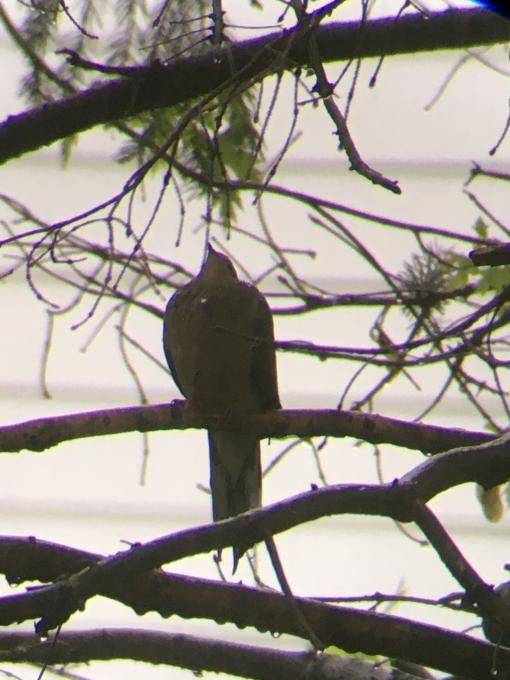
 American Goldfinch in early April. While not a good photo, this was the first time since last year that I’d seen these birds. According to the animation (https://ebird.org/science/status-and-trends/amegfi/abundance-map-weekly), however, they could be present in my area throughout the year. Perhaps nonbreeding plumage or an overall lower density in winter help explain their apparent absence.
American Goldfinch in early April. While not a good photo, this was the first time since last year that I’d seen these birds. According to the animation (https://ebird.org/science/status-and-trends/amegfi/abundance-map-weekly), however, they could be present in my area throughout the year. Perhaps nonbreeding plumage or an overall lower density in winter help explain their apparent absence.
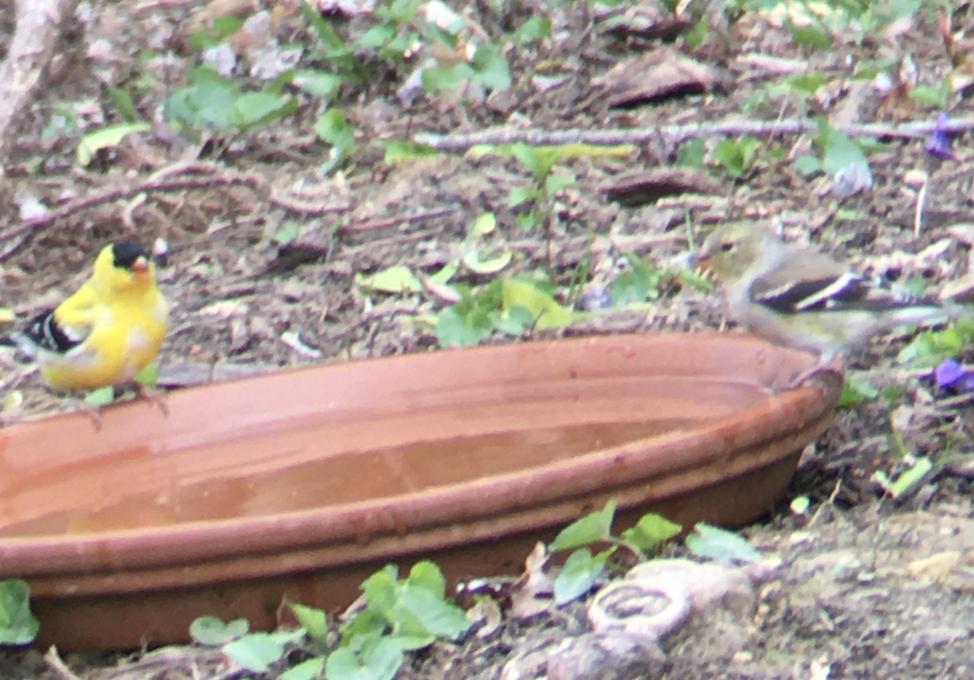 Gray Catbird in late April. I remember seeing these dapper fellows last year and am pleased to have noted one’s arrival the other (rainy) day. According to the animation (https://ebird.org/science/status-and-trends/grycat/abundance-map-weekly), these birds spend the non-breeding season along the Gulf Coast, the Caribbean, and in parts of Central America before moving into the midwest and northeastern parts of the United States.
Gray Catbird in late April. I remember seeing these dapper fellows last year and am pleased to have noted one’s arrival the other (rainy) day. According to the animation (https://ebird.org/science/status-and-trends/grycat/abundance-map-weekly), these birds spend the non-breeding season along the Gulf Coast, the Caribbean, and in parts of Central America before moving into the midwest and northeastern parts of the United States.
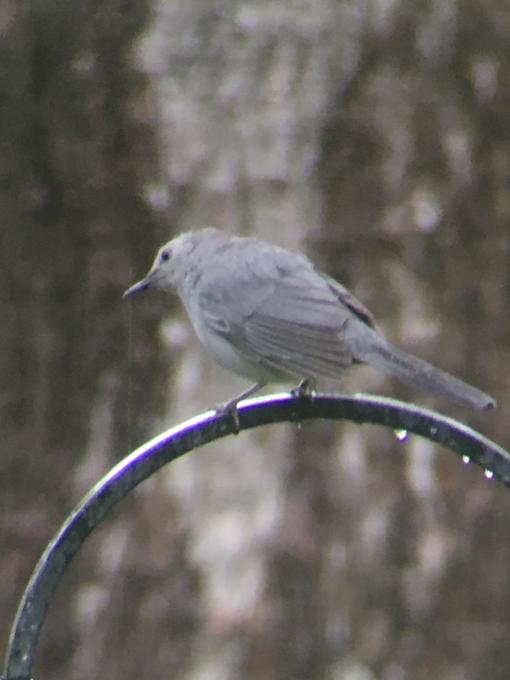 Travel safe, bird friends!
Travel safe, bird friends! 
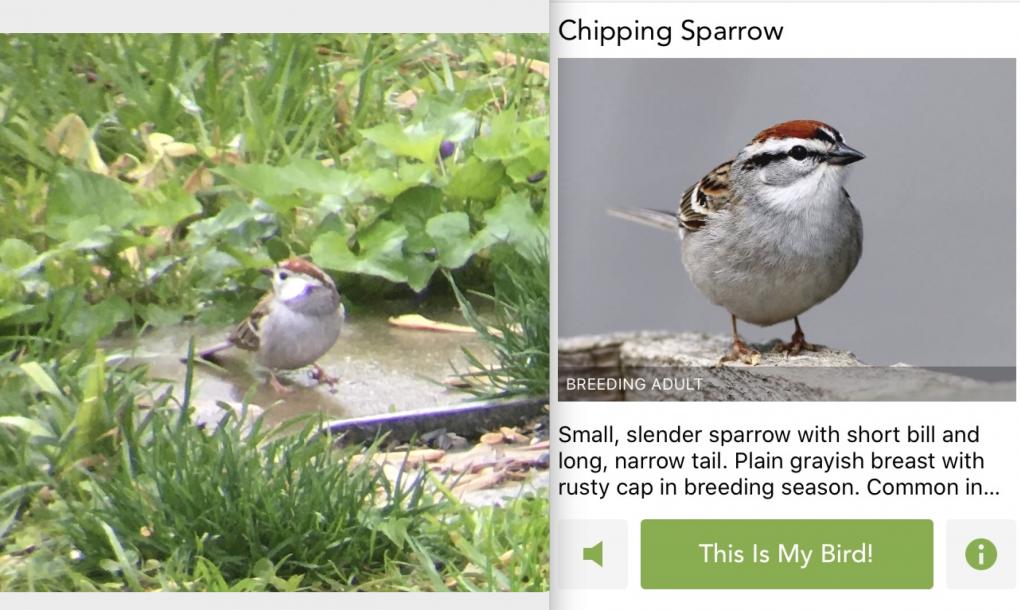
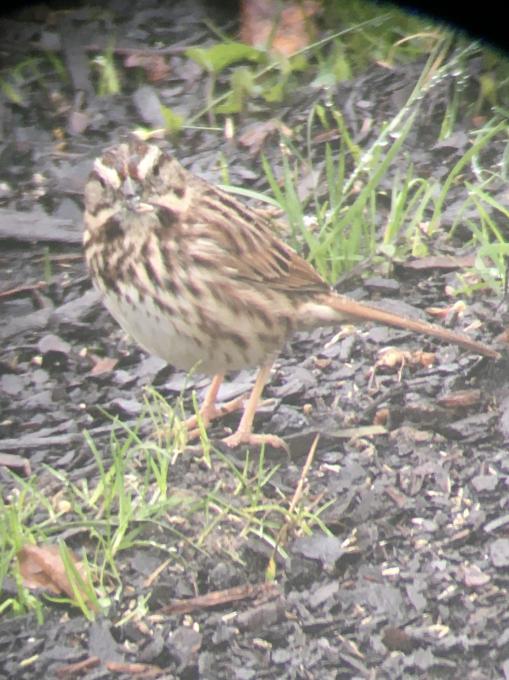
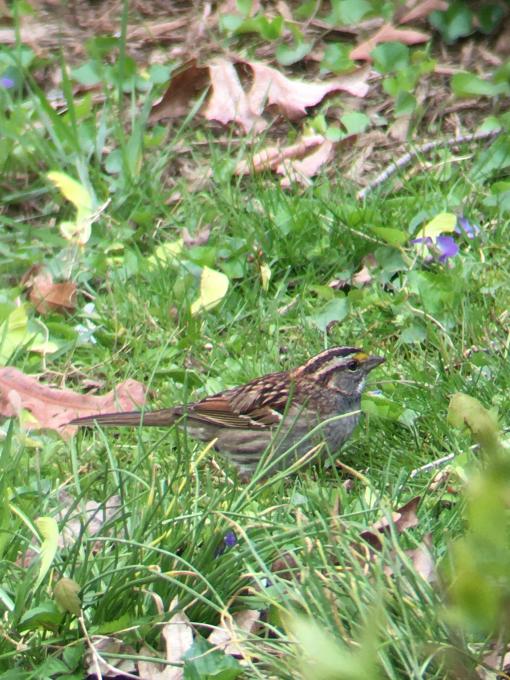
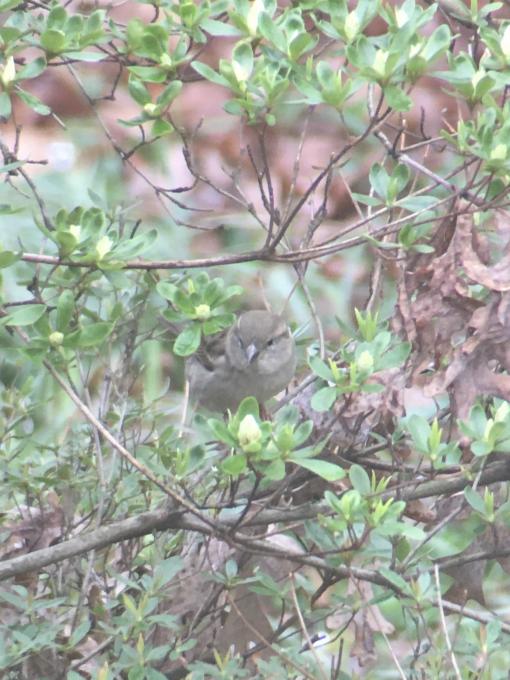
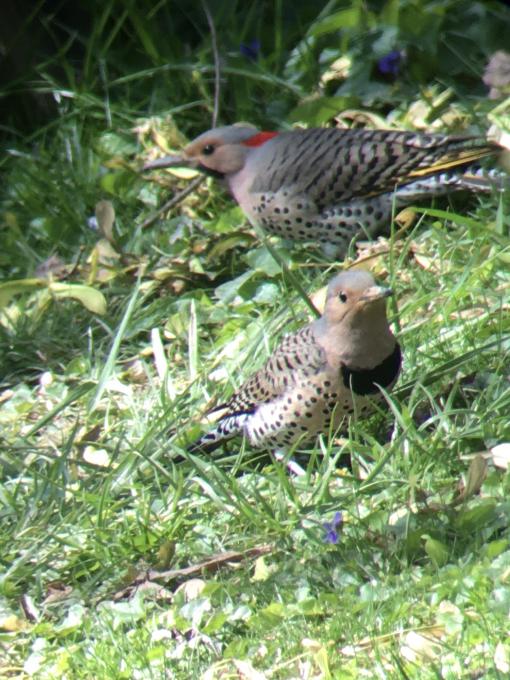 Songbirds/Finches and buntings: a Northern Cardinal pair (female in front, male in back). Spring is truly in the air as a number of pairs seem to be competing for a “top spot” in the yard!
Songbirds/Finches and buntings: a Northern Cardinal pair (female in front, male in back). Spring is truly in the air as a number of pairs seem to be competing for a “top spot” in the yard!
 Songbirds/Other: a Blue Jay pair (I’m not sure of the sex… but I like to imagine one of each). The Blue Jay didn’t fit nicely into the course’s Songbird categories, but I looked on AllAboutBirds and see that they belong to the crow family (Corvidae).
Songbirds/Other: a Blue Jay pair (I’m not sure of the sex… but I like to imagine one of each). The Blue Jay didn’t fit nicely into the course’s Songbird categories, but I looked on AllAboutBirds and see that they belong to the crow family (Corvidae).
